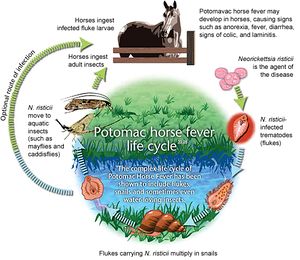Neorickettsia risticii: Difference between revisions
| Line 11: | Line 11: | ||
==Host-Symbiont Interaction == | ==Host-Symbiont Interaction == | ||
The interaction between N. risticii and the horse is a pathogenic one. The bacteria colonizes in the epithelial cells of the horses intestines and causes many adverse symptoms such as anorexia, fever, diarrhea, lethargy, and in some cases laminitis. | |||
The horse acquires N. risticii through ingesting a vector insect such as caddisflies or mayflies. | |||
==Molecular Insights into the Symbiosis== | ==Molecular Insights into the Symbiosis== | ||
Describe molecular/genetic studies on the symbiosis. | Describe molecular/genetic studies on the symbiosis. | ||
Revision as of 01:11, 21 November 2011
Ex. Potomac Horse Fever
Characteristics of the pathogen
Neorickettsia risticii is a member of the Erlichiaea family of bacteria. It is a gram-negative, coccus, and obligate bacterium.
The genome for Neorickettsia risticii was fully sequenced in 2009. The Neorickettsia risticii strain sequenced was the Illinois strain, which consists of one circular chromosome that has 879,977 base pairs, with a GC content of 41.3%. This chromosome encodes for 38 different RNA species and 898 different proteins.
Characteristics of the host
What host/s is/are involved? Is there host specificity? Are there secondary reservoirs?

Host-Symbiont Interaction
The interaction between N. risticii and the horse is a pathogenic one. The bacteria colonizes in the epithelial cells of the horses intestines and causes many adverse symptoms such as anorexia, fever, diarrhea, lethargy, and in some cases laminitis.
The horse acquires N. risticii through ingesting a vector insect such as caddisflies or mayflies.
Molecular Insights into the Symbiosis
Describe molecular/genetic studies on the symbiosis.
Ecological and Evolutionary Aspects
What is the evolutionary history of the interaction? Do particular environmental factors play a role in regulating the symbiosis?
Recent Discoveries
Describe two findings on the symbiosis published within the last two years.
References
[Sample reference] [[2] Seemanapalli SV, Xu Q, McShan K, Liang FT. 2010. Outer surface protein C is a dissemination-facilitating factor of Borrelia burgdorferi during mammalian infection. PLoS One 5:e15830.]
Edited by [Sierra Wangensteen], students of Grace Lim-Fong
